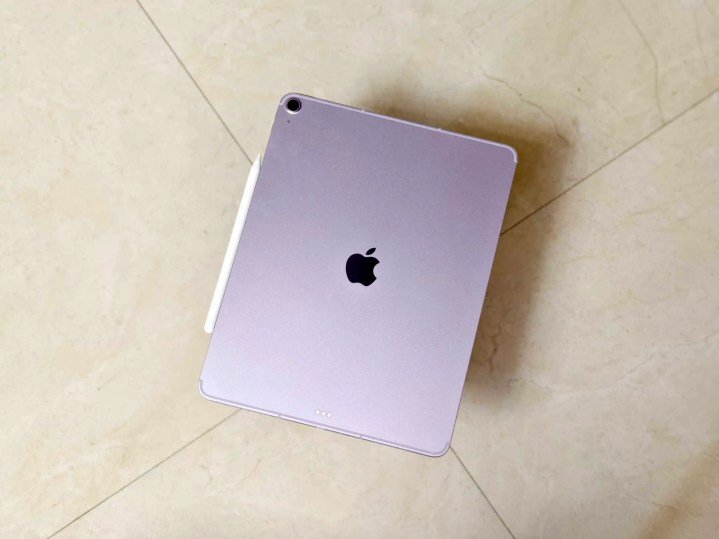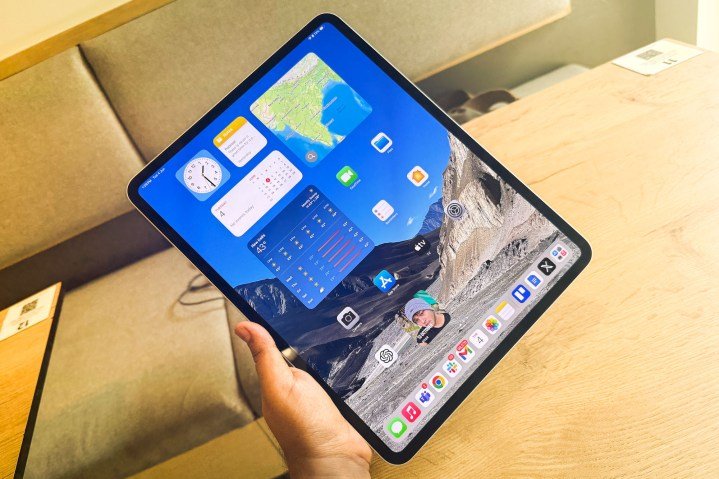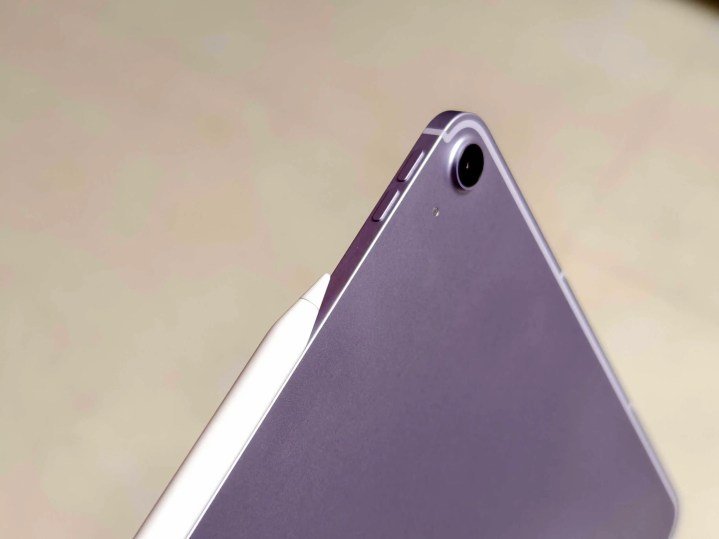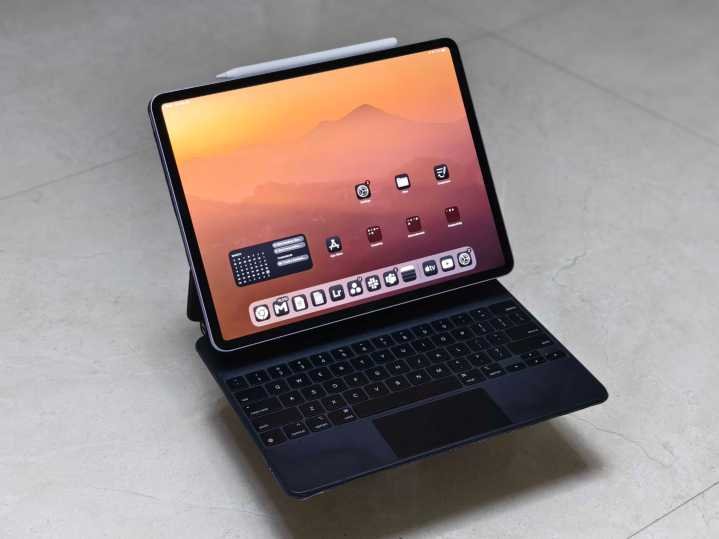The iPad Pro is Apple’s premier tablet computer, that offers power identical to a MacBook in a more convenient and portable layout. It was announced in May last year and continues to serve as Apple’s flagship iPad since then. Intriguingly though, Apple also announced an iPad Air at the same time last year with an M2 chip, and the same design was recently refurbished with M3 chips.
Superficially, both iPad models may seem very similar, especially since the iPad Air covers all the essential features from the iPad Pro, including support for the new Apple Pencil Pro, a similarly large footprint that will let you replace your laptop for most chores. Simultaneously, the $400 divide between the two devices must leave you wondering why Apple is charging extra for identical specs. The answer is complicated and more confusing than the comparison between the base iPad and the new iPad Air (2025).
But if you permit, we would take you through all the reasons why one might be a better fitting iPad for your needs, starting first with how they differ in specifications.
Apple iPad Air (2025) vs. iPad Pro (2024): specs
| iPad Air (2025) | iPad Pro (2024) | |
| Size | 11-inch: 247.6 x 178.5 x 6.1 mm (9.74 x 7.02 x 0.24 inches) 13-inch: 280.6 x 214.9 x 6.1 mm (11.04 x 8.46 x 0.24 inches) | 11-inch: 249.7 x 177.5 x 5.3 mm (9.83 x 6.99 x 0.21 in) 13-inch: 281.6 x 215.5 x 5.1 mm (11.09 x 8.48 x 0.20 in) |
| Weight | 11-inch: 460 grams (1.01 lbs) 13-inch: 616 grams (1.36 lbs) | 11-inch: 444 grams (1.03 lbs) 13-inch: 579 grams (1.28 lbs) |
| Screen | 11-inch: 2360 x 1640 pixels at 264 ppi 13-inch: 2732 x 2048 pixels at 264 ppi IPS LCD Fully laminated, anti-reflective coating | 11-inch: 2420 x 1668 pixels at 264 ppi 13-inch: 2752 x 2064 pixels at 264 ppi Tandem OLED Fully laminated, anti-reflective nanotexture coating |
| Brightness | 11-inch: 500 nits (SDR) 13-inch: 600 nits (SDR) | 11-inch: 500 nits (SDR) 13-inch: 600 nits (SDR) |
| Operating system | iPadOS 18 | iPadOS 18 |
| Storage | 128GB, 256GB, 512GB, 1TB | 256GB, 512GB, 1TB, 2TB |
| Processor | Apple M3 8-core CPU | Apple M4 11-inch: 9-core CPU 13-inch: 10-core CPU |
| RAM | 8GB | 8GB (256GB, 512GB), 16GB (1TB, 2TB) |
| Rear camera | 12MP wide, f/1.8 | 12MP wide, f/1.8 3D Time of Flight (ToF) depth sensor |
| Front camera | 12MP ultrawide, f/2.0 Center Stage and Smart HDR 4 | 12MP ultrawide, f/2.0 Center Stage and Smart HDR 4 |
| Video | Up to 4K at 60fps 1080p Slo-mo at up to 240fps | Up to 4K at 60fps 1080p Slo-mo at up to 240fps |
| Bluetooth | Bluetooth 5.3 | Bluetooth 5.3 |
| Ports | USB-C, Smart Connector | USB-C, Smart Connector |
| Authentication | Touch ID | Face ID |
| SIM card | eSIM | eSIM |
| Audio | Landscape stereo speakers Two microphones | Landscape stereo speakers Two microphones |
| Battery life | 11-inch: 28.9 watt-hour 13-inch: 36.6 watt-hour Up to 10 hours of surfing the web on Wi-Fi or watching video | 11-inch: 31.3 watt-hour 13-inch: 39 watt-hour Up to 10 hours of surfing the web on Wi-Fi or watching video |
| Network | Wi-Fi 6E 5G (sub-6GHz) on cellular models only | Wi-Fi 6E 5G (sub-6GHz) on cellular models only |
| Hardware keyboard support | Magic Keyboard for iPad Air Bluetooth Keyboards | Magic Keyboard for iPad Pro Bluetooth Keyboards |
| Colors | Space gray, blue, purple, Starlight | Space black, silver |
| Price | Starting at $599 | Starting at $999 |
Apple iPad Air (2025) vs. iPad Pro (2024): design

Both the iPad Air (2025) and the iPad Pro (2024) are large tablets with either 11-inch or 13-inch displays. The dimensions on both are barely a few millimeters apart. Telling the two apart just by looking from the front will require some close investigation, with the only telling factor being the Face ID sensor on the iPad Pro (2024) — the iPad Air (2025), just like the model before it, has a Touch ID sensor placed in the power button instead.
The differences become more apparent when you hold the two iPad models in your hands. The first indicator is the slimness of the iPad Pro, which Apple claims to be the thinnest iPad yet. The iPad Pro 11-inch measures just 5.3mm in thickness (excluding the camera bump) while the 13-inch variant is even thinner, measuring just 5.1mm. In comparison, the iPad Air, irrespective of its size, measures 6.1mm. A single millimeter shouldn’t have much of a difference, unless you are after desire the sensation of holding something uniquely premium, which is what Digital Trends writer Nadeem Sarwar did when he first held it.

Of course, the feeling of novelty would fade away with time, but what wouldn’t is the fact that the iPad Pro is noticeably lighter than the Air, especially in its 13-inch variant. This makes the Pro easier to carry, in the hand or in a backpack, but you might need to be more attentive and avoid putting pressure, which might cause the slim iPad Pro to bend. It would be wise to slap a case on the iPad, though it wouldn’t hurt to get one for the Air either.
Another difference between the two slates will be the colors on offer. Even though Apple uses aluminum-crafted shells for both, the iPad Pro has more appealing colors, including silver and Space black. The iPad Air, on the other hand, gets Space gray, a champagne-like Starlight, along with two cheerful options in blue and purple.
Overall, both iPad models are quite easy to recommend. But if you want the superior product irrespective of the price, the iPad Pro is what you should go for.
Winner: iPad Pro (2024)
Apple iPad Air (2025) vs. iPad Pro (2024): display

Despite the identical builds, the display is where the iPad Air (2025) vs. iPad Pro (2024) lie far apart. With the Air gets a Retina LCD with a glum 60Hz refresh rate, the iPad Pro gets a much more compelling Tandem OLED. Now while both the displays have the same level of clarity, the OLED on the iPad Pro is miles ahead.
For starters, the OLED is twice as bright as the Air’s LCD panel. While it gets the usual advantage of an OLED panel, Apple uses two layers of organic LEDs, which also give the panel its name. The dual OLED stack also allows for better color accuracy, improved power efficiency, and longer-lasting materials. You will immediately notice this improvement if you have used any previous iPad.
The Tandem OLED makes viewing any high resolution content or media a delight on this screen. It’s also extremely useful if your work relies on being accurate with colors, such as with graphics designing, illustrating, video editing, etc. And after work, you can utilize the 120Hz panel — with refresh rate that varies between 10 and 120Hz — to enjoy playing the hoard of AAA games ported for the iPad and not expect any lag.

This display is also excellent for watching movies and TV shows, and Apple claims it can go up to 1,600 nits with HDR content. The slate supports Dolby Vision, which will further enhance the visibility and contrast, even in extremely bright or extremely dim scenes.
If you tend to use the iPad in bright scenarios, such as inside a studio, a well-lit workspace, or just outdoors, you might want to splurge and get the optional nano-texture anti-reflective coating on the display. The nano-texture is not simply a film but a solution that Apple has deeply embedded it within the screen so it doesn’t affect how scribbling with the Apple Pencil feels. If that sounds promising, you would have to opt for at least 1TB of storage since Apple limits it to the higher-end models.
If we were to choose the winner solely based on the display, the iPad Pro (2024) would beat the iPad Air (2025) by a long margin.
Winner: iPad Pro (2025)
Apple iPad Air (2025) vs. iPad Pro (2024): performance

The different internals further widen the performance gap between the iPad Air (2025) vs. iPad Pro (2024). Despite being a year older, the iPad Pro (2024) comes with Apple’s more advanced M4 chip inside. Based on the storage variant you choose, you get either a nine-core or a 10-core CPU along with a 10-core GPU on the M4 chipset, fabricated with an enhanced 3nm process by TSMC. The chipset also gets a more powerful neural engine, capable of processing up to 38 TOPS or trillion operations per second.
Meanwhile, the iPad Air (2025) comes with an older M3 chipset, which, although a refresh over the M2 in the previous iPad Air, still lags behind the M4 in its power. Fortunately, Apple is at least transparent about its choice of chipsets and is not simply rebranding older chipsets as new ones as other chipmakers like Qualcomm.

It gets an eight-core CPU as standard along with an eight-core GPU, both of which deliver less power output than the counterparts on M4. The neural engine, too, is only capable of 18 TOPS. And finally, the M4 chip has a wider memory width, which means it will allow more applications to run parallelly without falling short in resources.
Overall, these differences translate to a better performance on iPad Pro (2024). Not just that, the newer chip is designed to last longer, which means that despite being launched a year prior, the iPad Pro (2024) may outlast the iPad Air (2025) in terms of software support.
Simply from a performance perspective, the iPad Pro is the clear winner.
Winner: iPad Pro (2024)
Apple iPad Air (2025) vs. iPad Pro (2024): software

The software experience is one area where the iPad Air (2025) and the iPad Pro (2024) have no differences. Both the tablets run iPadOS, and while the iPad Pro originally shipped with iPadOS 17, it can be upgraded to iPadOS 18, and is expected to support several upcoming generations of the interface. The iPad Air (2025), on the other hand, comes with iPadOS 18 out of the box, bringing features such as customizable Control Center, icon customization features, and Apple Intelligence.
Both of these are expected to get iPadOS 19, which is expected to bring a more refined user experience and is anticipated to be the biggest graphical refresh in over a decade, aimed at unifying the visuals in iOS, iPadOS, and macOS. Apple is expected to draw inspiration from glass, and is expected to reveal the details at the WWDC 2025 annual conference.
Winner: Tie
Apple iPad Air (2025) vs. iPad Pro (2024): cameras

There aren’t any differences between the iPad Air (2025) vs. iPad Pro (2024) in terms of the primary rear camera. Both house a 12MP primary shooter with similar technical capabilities. Apple has taken the liberty to not use an exceptional camera on the Pro, despite its pricing, as few people actually capture photos using a tablet’s rear camera. However, if you were to shoot videos with it, both iPad models can capture 4K videos at up to 60fps. While the previous iPad Pro also came with an ultrawide camera, Apple dropped it when it switched to the slimmer profile with the 2024 model.
The iPad Pro gets an additional 3D depth sensor that captures time of flight using LiDAR technology. It can be used to accurately map the distance between the iPad Pro and other physical objects. There are few practical applications for the sensor, unless you work with 3D models, but Apple claims it empowers the iPad to bridge the gap between physical and virtual objects. You can use it to accurately measure the length of objects up to five meters away from the iPad or use it within apps that require physical tracking of the human body. You can also take 3D stills and experience them on the Apple Vision Pro or share them with anyone who does.

Finally, the front cameras on the iPad Air (2025) vs. iPad Pro (2024) are also identical, with both offering Center Stage to keep you positioned in the middle of the frame during video calls. Additionally, Face ID on the iPad Pro enables features such as Animoji and Memoji alongside portrait lighting effects.
With an extra set of features, the iPad Pro has a slight edge in terms of cameras.
Winner: iPad Pro (2024)
Apple iPad Air (2025) vs. iPad Pro (2024): accessories
Apple Pencil

There are chiefly two accessories that go well with the iPad Air and iPad Pro. These include the Apple Pencil, which also comes in two varieties, called “Apple Pencil with USB-C” and “Apple Pencil Pro,” and both of these work with both iPad models.
Even though the two Pencils look quite similar, some key distinctions will make a huge difference. First, the Apple Pencil Pro attaches magnetically to the side of the iPad for charging, which is convenient for times you are not using it. Even though the other Apple Pencil (which is not to be confused with the older Apple Pencil 2nd Generation) also attached magnetically, it can only be charged using the USB-C port, which adds the extra inconvenience of carrying an additional cable.
Additionally, the Apple Pencil Pro has extra features, including barrel roll, which rotates where the pen or brush is pointing when you physically roll the pencil. The Pencil Pro also supports squeeze gesture, haptic feedback, and support for Apple’s Find My app. The Apple Pencil USB-C is ideal if you just want a rather affordable solution for taking notes and occasional doodling, the $79 Apple Pencil with USB-C does the job. But if you are serious about using the iPad Air or Pro as your drawing station, the $129 Apple Pencil Pro makes much more sense.
Magic Keyboard

The other accessory we think you should know about is the Apple Magic Keyboard. This keyboard folio case is designed with inspiration from the MacBook and will certainly offer a more plush and optimized experience if you are using it with your iPad Air or iPad Pro.
Unlike the Apple Pencil, though, there are different versions of the Magic Keyboard for the iPad Air (M3) and iPad Pro (M4) despite both iPad models being so close in size. The keyboard for iPad Pro comes with a more premium metallic top, a backlit keyboard, a bigger trackpad with haptic feedback, for just $30 extra. The keyboard for the iPad Air (M3), though priced at $26, lacks those features, some of which can be dealbreakers. Ironically, there is another $299 variant — the Magic Keyboard for iPad Air (M2), which has backlighting but still no haptic feedback.

These appear like tactics to upsell the iPad Pro for those who truly want a laptop-like experience from the iPad, even when the Air is perfectly capable of that. You might feel even more bitter on learning that the iPad Pro’s Magic Keyboard supports iPad Air (2022) and older models, and Apple really didn’t have a good reason, at least from the consumers’ perspective, to change that.
So overall, the iPad Pro gets slightly better support for accessories, but you need to pay slightly more for that experience. So it’s fair for us to leave the choice to you instead of picking a winner in the category.
Winner: Tie
Apple iPad Air (2025) vs. iPad Pro (2024): price and availability
The iPad Air starts for $599, which is what you must pay for the 128GB variant with an 11-inch display. With more storage and the addition of cellular connectivity, prices will go up accordingly. The 13-inch model starts at $799.
The iPad Pro, on the other hand, has a $999 starting price, but you get a 256GB as the base storage option instead of 128GB. However, if you want the extra core on the processor, you would need to pick the model with at least 1TB of storage, which costs $1,599. Add nano-texture anti-reflective glass and the price will go up by another $100, reaching $1,699.
If you’d like to include a Magic Keyboard case, you will have to shell out $269 more for the case fitting the iPad Air and $299 for the iPad Pro. Even though the latter costs extra, you also get features like a bigger trackpad with haptic feedback and a metal top instead of plastic. And as we discussed above, the Magic Keyboard with the iPad Pro just feels more premium.
Apple iPad Air (2025) vs. iPad Pro (2024): verdict

The vast price difference between the iPad Air (2025) and the iPad Pro (2024) will be the primary defining factor between the two tablets. But if we assume money isn’t the deciding factor, we can rely on your utility for the iPad you are going to buy.
If you want an iPad simply for reading — web pages, e-books, documents, etc. — the iPad Air is good enough. With enough power in it, it can even be a good tablet for some occasional gaming or experiencing Apple Intelligence features. Want to dock it to a screen — or a pair of VR glasses — and use it as a desktop computer? The iPad Air is ready for that too.
The why would one want the iPad Pro? Well, for starters, you get a stunningly gorgeous display, the M4 chip’s extra muscle power if you wish to push it further with tasks like video editing or 3D modeling. Storage options up to 2TB, an optional smudge-proof and anti-reflective coating on the screen, and the additional benefit of an almost MacBook-like typing and trackpad experience make it a reliable workhorse — an expensive one but surely useful. This will equate to a MacBook but with an excellent touchscreen. It’s not the best iPad ever for no reason.
While it may still not be able to serve the same experience of running desktop apps, it surely has the capability if Apple ever decides to merge the development channels for iPadOS and macOS. On the contrary, all this power might also seem overkill if you have no real use for it. Another minor reason you might want to consider buying the iPad Pro over the iPad Air is the LiDAR depth sensor, which can let you scan your surroundings and recreate 3D models, which can be further used for printing, or jobs like house development planning or interior design. Of course, the Pro will also leave a good impression on your clients.
Again, if money is no bar, and you want the ultimate experience, don’t think twice before buying the iPad Pro (2024). Apple will tempt you to spend at least $1,699 to get the one with the nano-texture glass, and you might as well go for it if your budget allows. If you just want the better iPad and would not be swayed by the nitty-gritty, the base $999 should be equally satisfying. If, however, budget is constrained, and you want value for your hard-earned money — and have no real use for the iPad Pro, go or the iPad Air (2025), but choose at least 256GB of storage to secure for the future.













